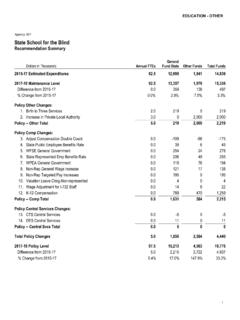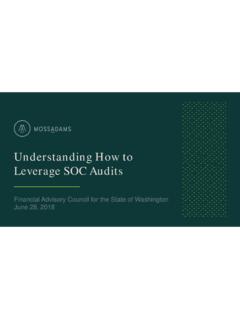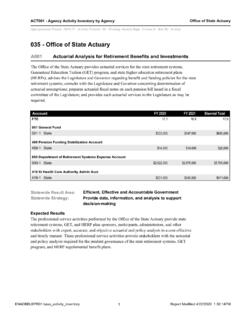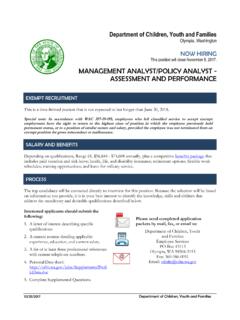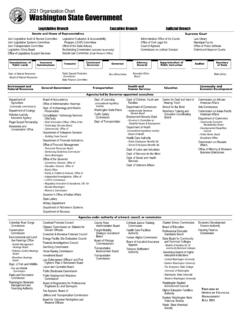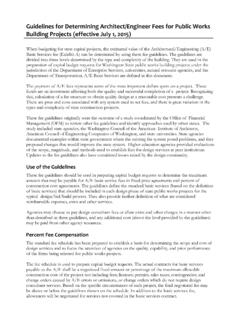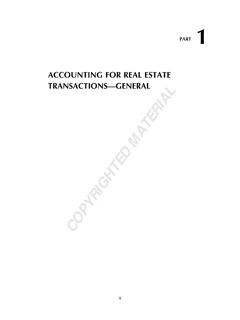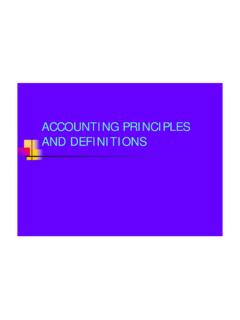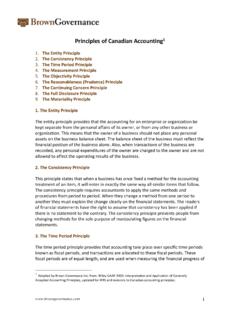Transcription of 80.20 - Generally Accepted Accounting Principles
1 Accepted Accounting PrinciplesSectionTitleEffective DatePage state adopts Generally Accepted Accounting Principles (GAAP)July 1, constitutes GAAP?July 1, GAAP requires fund accountingJuly 1, categories used in governmental accountingJuly 1, reporting requirementsJuly 1, is the financial reporting entity?July 1, focus and basis of accountingJune 1, for capital assets and long-term obligationsJuly 1, budgetary requirementsJuly 1, Discussion and AnalysisJuly 1, financial statementsJune 1, financial statementsJune 1, state adopts Generally Accepted Accounting Principles (GAAP)July 1, 2001 Generally Accepted Accounting Principles (GAAP) are uniform minimum standards of and guidelines to financial Accounting and reporting.
2 GAAP establishes appropriate measurement and classification criteria for financial reporting. Adherence to GAAP provides a reasonable degree of comparability among the financial reports of state and local governmental units. In accordance with RCW , the Office of Financial Management adopts GAAP as applicable to state Administrative and Accounting ManualChapter constitutes GAAP?July 1, 2015 The hierarchy of GAAP governs what constitutes GAAP for state governments, including government-owned colleges and universities and health care providers. It details the priority sequence of pronouncements that the state should look to for Accounting and reporting guidance.
3 The Governmental Accounting Standards Board (GASB) established the following hierarchy of authoritative GAAP for state and local Statements (Category A). Technical Bulletins; GASB Implementation Guides; and literature of the American Institute of Certified Public Accountants (AICPA) cleared by the GASB (Category B).If the Accounting treatment for a transaction or other event is not specified by a pronouncement in Category A, a governmental entity should consider whether the Accounting treatment is specified by a source in Category the Accounting treatment for a transaction or other event is not specified in either Category A or B, a government Generally should first consider Accounting Principles for similar transactions covered in the above categories and then may consider other nonauthoritative Accounting literature that does not conflict or contradict authoritative Accounting literature include: GASB Concept Statements.
4 Pronouncements and literature of the Financial Accounting Standards Board, Federal Accounting Standards Advisory Board, International Public Sector Accounting Standards Board, International Accounting Standards Board and AICPA literature not cleared by the GASB; Practices that are widely recognized and prevalent in state and local government; Literature of other professional associations or regulatory agencies; and Accounting textbooks, handbooks and GAAP requires fund accountingJuly 1, 2001 Among the basic Principles of governmental GAAP is fund Accounting . Because of the diverse nature of governmental operations and the numerous legal and fiscal constraints under which those operations must be conducted, it is impossible to record all governmental financial transactions and balances in a single Accounting entity.
5 Therefore, unlike a private business which is accounted for as a single entity, a governmental unit is accounted for through separate funds, each of which is a fiscal and Accounting entity with a self-balancing set of Administrative and Accounting ManualChapter categories used in governmental accountingJuly 1, 2010 Funds are categorized by type to indicate both the sources of the fund's financial resources and the nature of activities financed. There are three broad categories of funds used in governmental funds are used to account for most typical governmental functions. The acquisition, use, and balances of the state s expendable financial resources and the related current liabilities (except those accounted for in proprietary funds), are accounted for through governmental funds.
6 There are five types of governmental funds: General Fund - used to account for all financial resources of the state not required to be accounted for in some other fund. Includes both the Basic Account and Administrative Accounts. Special Revenue Funds - used to account for the proceeds of specific revenue sources (other than trusts for individuals, private organizations, or other governments or for major capital projects) that are restricted or committed to expenditures for specified purposes other than debt service or capital projects. Debt Service Funds - used to account for the accumulation of resources that are restricted, committed, or assigned for, and the payment of, general long-term debt principal and interest.
7 Capital Projects Funds - used to account for financial resources that are restricted, committed, or assigned to expenditures for the acquisition and construction of major capital facilities (other than those financed by proprietary funds or in trust funds for individuals, private organizations, or other governments). Permanent Funds - used to account for resources that are restricted to the extent that only earnings, and not principal, may be used for the benefit of the state or its funds are used to account for a government's ongoing organizations and activities that are similar to businesses found in the private sector.
8 These funds are considered self-supporting in that the services rendered by them are Generally financed through user charges or on a cost reimbursement basis. There are two types of proprietary funds: Enterprise Funds - used to account for any activity for which a fee is charged to external users for goods or services. Activities are required to be reported as enterprise funds, in the context of the activity s principal revenue sources, if any one of the following criteria is met: activity is financed with debt that is secured solely by pledge of the net revenues from fees and charges of the activity,State Administrative and Accounting ManualChapter or regulations require that the activity s costs of providing services, including capital costs (such as depreciation or debt service), be recovered with fees and charges, rather than with taxes or similar revenues, pricing policies of the activity establish fees and charges designed to recover its costs, including capital costs (such as depreciation or debt service).
9 Internal Service Funds - used to account for the provision of goods or services by one department or agency to other departments or agencies of the state, or to other governmental units, on a cost-reimbursement basis. Internal service funds should only be used if the state is the predominant participant in the funds are used to account for assets held by a governmental unit in a trustee capacity or as an agent for individuals, private organizations, and/or other governmental units. There are four types of fiduciary funds: Pension (and other employee benefit) Trust Funds - used to report resources that are required to be held in trust by the state for the members and beneficiaries of defined benefit pension plans, defined contribution pension plans, and other employee benefit plans.
10 Investment Trust Funds - used to report the external portion of the Local Government Investment Pool, which is reported by the state as the sponsoring government. Private-Purpose Trust Funds - used to report trust arrangements, other than pension and investment trusts, under which principal and income benefit individuals, private organizations, or other governments. The resources held under these arrangements are not available to support the government s own programs. Custodial Funds - used to account for resources held by the state in a purely custodial capacity for other governments, private organizations or individuals that are not required to be reported in pension (and other employee benefit) trust funds, investment trust funds, or private-purpose trust funds.
